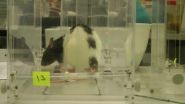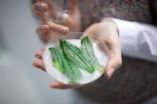(Press-News.org) The first large-scale, comprehensive analysis of the genomic diversity of Mexico — led by researchers at the Stanford University School of Medicine, the University of California-San Francisco and the Mexican National Institute of Genomic Medicine — has identified a dazzling mosaic of genotypes and population substructures across the country.
Some groups are as genetically different from one another as Europeans are from East Asians.
The study, which will be published June 13 in Science, soundly refutes the current practice of lumping together Mexicans or Latinos as a homogenous group for genetic, clinical or population studies. In particular, the researchers found that variations in Native American ancestry among Mexicans and Mexican Americans significantly affect biomedical traits, such as lung function, emphasizing the importance of incorporating fine-scale ethnic information into clinical practice.
The analysis represents an international collaboration of researchers from the United States, Mexico, Spain and the United Kingdom.
"Understanding the genetic structure of a population is important for understanding its population history, as well as designing studies of complex biomedical traits, including disease susceptibility," said Stanford professor of genetics Carlos Bustamante, PhD. "As we deploy genomics technology in previously understudied populations like those of Latin America, we discover remarkable richness in the genetic diversity of these important groups and why it matters for health and disease."
"Mexico harbors one of the largest amounts of pre-Columbian genetic diversity in the Americas," said Andres Moreno-Estrada, MD, PhD, life sciences research associate at Stanford. "For the first time, we've mapped this diversity to a very fine geographic scale, and shown that it has a notable physiological impact on an important clinical trait: lung function."
Bustamante, who directs the Stanford Center for Computational, Evolutionary and Human Genomics, shares senior authorship of the study with Esteban Burchard, MD, MPH, professor of bioengineering and therapeutic sciences and medicine at UCSF. Moreno shares lead authorship with Christopher Gignoux, PhD, a postdoctoral scholar now at Stanford and previously at UCSF, and Juan Carlos Fernandez Lopez, a researcher at the Mexican genomic institute.
Burchard noted that in lung diseases, such as asthma or emphysema, a person's ancestry at specific locations on their genes matters. "In this study, we realized that for disease classification it also matters what type of Native American ancestry you have," he said.
The researchers compared variation in more than 1 million single nucleotide polymorphisms, or SNPs, among 511 people representing 20 indigenous populations from all over Mexico. They compared these findings with SNP variation among 500 people of mixed Mexican, European and African descent (a category called mestizos) from 10 Mexican states, a region of Guadalajara and Los Angeles, as well as with SNP variation among individuals from 16 European populations and the Yoruba people of West Africa.
The researchers found that Mexico's indigenous populations diverge genetically along a diagonal northwest-to-southeast axis, with differences becoming more pronounced as the ethnic groups become more geographically distant from one another. In particular, the Seri people along the northern mainland coast of the Gulf of California and a Mayan people known as the Lacandon found near the country's southern border with Guatemala are as genetically different from one another as Europeans are from Chinese.
"Many of these Native American groups have been and remain very geographically isolated," said Gignoux. "We found they share very little genetically with other neighboring groups." When rare gene flow did occur, it was concentrated among populations on the country's coastlines, the researchers found.
Much of Mexico, however, is populated by people of mixed ancestry, primarily as a result of European colonization. The researchers found that these individuals had a large amount of European and Native American ancestry, coupled with a relatively small amount (5 percent or less) of African ancestry.
"Because this mixing happened fairly recently within the spectrum of human history," said Gignoux, "we can use genomic data techniques to identify which segments of an individual's genome correspond to specific ancestral populations. What portion comes from Europe? What from Native Americans? And then we can find out how that fits into the pattern of modern-day populations."
Consistent with the history of the Spanish occupation and colonization of Mexico, the researchers found that the European portion of the mixed-individuals' genomes broadly corresponded to that of modern-day inhabitants of the Iberian Peninsula. The Native American portion of their genomes, however, was more likely to correspond to that of local indigenous people. A person in the Mexican state of Sonora, for example, was likely to have ancestors from indigenous groups in the northern part of the country, whereas someone from Yucatan was more likely to have a southern native component in their genome, namely Mayan.
"We were really fascinated by these results because we had expected that 500 years of population movements, immigration and mixing would have swamped the signal of pre-Columbian population structure," said Bustamante.
Although it wasn't possible to precisely identify the specific ethnic group from which a person of mixed heritage had descended, the researchers were able to ascertain a person's ancestry at a regional level at an unprecedented level of resolution.
"We've asked these questions in other studies on a larger scale within Europe and the Caribbean," said Moreno-Estrada. "When we tried to identify where exactly within Mexico these Native American sequences originate, we found we could be surprisingly accurate — beyond what anyone has ever been able to do before. We've demonstrated that we don't have to stop at the continental level."
Finally, the researchers wondered if differences in Native American ancestry could affect biomedical traits known to vary among ethnic groups, like lung function. To find out, they studied the outcomes of two studies measuring lung function in Mexican and Mexican American children: the Mexico City Childhood Asthma Study and the Genetics of Asthma in Latino Americans (the largest pediatric asthma study of Latino populations in the United States).
The lung function tests assessed by the researchers measure the volume of air a person can expel in one second — designated as FEV1. FEV1 values are used by clinicians to diagnose asthma and other lung and airway diseases.
Deviations from standard values can indicate a need for intervention, but because a healthy normal for one ethnic group may be borderline abnormal for another, different reference standards are used for different ethnicities.
The researchers drew on data that calculated the predicted normal FEV1 for each subject based on age, gender, height and ethnicity (in this case, the reference was a standard used for all people of Mexican descent). To understand implications of these results within Mexico, they modeled the predicted lung function across Mexico, accounting for differences in local Native American ancestry for a large cohort of mestizos from eight states. The model predicts a marked difference across the country, with the average predicted FEV1 for a person from the northern state of Sonora and another from the state of Yucatan differing by about 7.3 percent. (That is, the population from Sonora has predicted values that were slightly higher than the average for the country, and those from the Yucatan were slightly lower.)
"There's a definite predicted difference that's due only to an individual's Native American ancestry," said Gignoux. "Variations in genetic composition clearly give a different physiological response."
The researchers emphasize that a lower FEV1 does not necessarily mean a particular ethnic group has impaired lung function. Disease analysis takes place in the context of standardized values of matched populations, and the study points out how it is necessary to match people correctly to their ethnic backgrounds before making clinical decisions.
"We're moving beyond blanket definitions like Mexican or Latino," said Moreno-Estrada. "Now we're putting finer details on that map. Those broad terms imply common ground among populations, but we're finding that it's much more like a mosaic."
"This can shape public health and public policy," Burchard said. "We now have a map of Mexico that will help researchers make those clinical and public health decisions."
INFORMATION:
Other Stanford authors are former graduate student Fouad Zakharia, PhD; postdoctoral scholars Martin Sikora, PhD, and Karla Sandoval, PhD; graduate student Patricia Ortiz-Tello; undergraduate student Victoria Robles; and former postdoctoral scholar Eimear Kenny, PhD.
The study was supported by the Federal Government of Mexico, the Mexican Health Foundation, the Gonzalo Rio Arronte Foundation, the George Rosenkranz Prize for Health Care Research in Developing Countries, the UCSF Chancellor's Research Fellowship, the National Institutes of Health (grants GM007175, 5R01GM090087, 2R01HG003229, ES015794, GM007546, GM061390, HL004464, HL078885, HL088133, RR000083, P60MD006902 and ZIA ES49019), the National Science Foundation, a Robert Wood Johnson Foundation Amos Medical Faculty Development Award, the Sandler Foundation, the America Asthma Foundation and the National Institute of Environmental Health Sciences.
Bustamante is on the advisory board of a project at 23andMe and on the scientific advisory boards of Personalis Inc.; InVitae; Etalon Inc.; and Ancestry.com.
Information about Stanford's Department of Genetics, which also supported the work, is available at http://genetics.stanford.edu.
The Stanford University School of Medicine consistently ranks among the nation's top medical schools, integrating research, medical education, patient care and community service. For more news about the school, please visit http://mednews.stanford.edu. The medical school is part of Stanford Medicine, which includes Stanford Hospital & Clinics and Lucile Packard Children's Hospital Stanford. For information about all three, please visit http://stanfordmedicine.org/about/news.html.
Print media contact: Krista Conger at (650) 725-5371 (kristac@stanford.edu)
Broadcast media contact: M.A. Malone at (650) 723-6912 (mamalone@stanford.edu)
Vast genetic diversity among Mexicans found in large-scale study
2014-06-12
ELSE PRESS RELEASES FROM THIS DATE:
Broad Institute, MGH researchers chart cellular complexity of brain tumors
2014-06-12
Scientists from the Broad Institute and Massachusetts General Hospital (MGH) have conducted a first-of-its-kind study that characterizes the cellular diversity within glioblastoma tumors from patients. The study, which looked at the expression of thousands of genes in individual cells from patient tumors, revealed that the cellular makeup of each tumor is more heterogeneous than previously suspected. The findings, which appear online in Science Express, will help guide future investigations into potential treatments for this devastating disease.
This is the first time ...
Mexican genetics study reveals huge variation in ancestry
2014-06-12
In the most comprehensive genetic study of the Mexican population to date, researchers from UC San Francisco and Stanford University, along with Mexico's National Institute of Genomic Medicine (INMEGEN), have identified tremendous genetic diversity, reflecting thousands of years of separation among local populations and shedding light on a range of confounding aspects of Latino health.
The study, which documented nearly 1 million genetic variants among more than 1,000 individuals, unveiled genetic differences as extensive as the variations between some Europeans and Asians, ...
Father's age influences rate of evolution
2014-06-12
The offspring of chimpanzees inherit 90% of new mutations from their father, and just 10% from their mother, a finding which demonstrates how mutation differs between humans and our closest living relatives, and emphasises the importance of father's age on evolution.
Published today in Science, researchers from the Wellcome Trust Centre for Human Genetics and the Biomedical Primate research Centre in the Netherlands looked at whether, in chimpanzees, there was a heightened risk of fathers passing on mutations to their children compared to humans.
In humans, each individual ...
New evidence for oceans of water deep in the Earth
2014-06-12
Researchers from Northwestern University and the University of New Mexico report evidence for potentially oceans worth of water deep beneath the United States. Though not in the familiar liquid form -- the ingredients for water are bound up in rock deep in the Earth's mantle -- the discovery may represent the planet's largest water reservoir.
The presence of liquid water on the surface is what makes our "blue planet" habitable, and scientists have long been trying to figure out just how much water may be cycling between Earth's surface and interior reservoirs through ...
With the right rehabilitation, paralyzed rats learn to grip again
2014-06-12
VIDEO:
This video depicts Restored grasping after immunotherapy and rehabilitative training.
Click here for more information.
Only if the timing, dosage and kind of rehabilitation are right can motor functions make an almost full recovery after a large stroke. Rats that were paralyzed down one side by a stroke almost managed to regain their motor functions fully if they were given the ideal combination of rehabilitative training and substances that boosted the growth of nerve fibers. ...
Unexpected origin for important parts of the nervous system
2014-06-12
A new study from Karolinska Institutet in Sweden shows that a part of the nervous system, the parasympathetic nervous system, is formed in a way that is different from what researchers previously believed. In this study, which is published in the journal Science, a new phenomenon is investigated within the field of developmental biology, and the findings may lead to new medical treatments for congenital disorders of the nervous system.
Almost all of the body's functions are controlled by the autonomous, involuntary nervous system, for example the heart and blood vessels, ...
Scientists discover link between climate change and ocean currents over 6 million years
2014-06-12
Scientists have discovered a relationship between climate change and ocean currents over the past six million years after analysing an area of the Atlantic near the Strait of Gibraltar, according to research published today (Friday, 13 June) in the journal Science.
An expedition of scientists, jointly led by Dr Javier Hernandez-Molina, from the Department of Earth Sciences at Royal Holloway, University of London, examined core samples from the seabed off the coast of Spain and Portugal which provided proof of shifts of climate change over millions of years.
The team ...
Habitat fragmentation increases vulnerability to disease in wild plants
2014-06-12
Proximity to other meadows increases disease resistance in wild meadow plants, according to a study led by Anna-Liisa Laine at the University of Helsinki. The results of the study, analysing the epidemiological dynamics of a fungal pathogen in the archipelago of Finland, will be published in Science on 13 June 2014.
The study surveyed more than 4,000 Plantago lanceolata meadows and their infection status by a powdery mildew fungus in the Åland archipelago of Finland. The surveys have continued since 2001, resulting in one of the world's largest databases on disease dynamics ...
Quantum computation: Fragile yet error-free
2014-06-12
This news release is available in German and Spanish. Even computers are error-prone. The slightest disturbances may alter saved information and falsify the results of calculations. To overcome these problems, computers use specific routines to continuously detect and correct errors. This also holds true for a future quantum computer, which will require procedures for error correction as well: "Quantum phenomena are extremely fragile and error-prone. Errors can spread rapidly and severely disturb the computer," says Thomas Monz, member of Rainer Blatt's research group ...
Movies with gory and disgusting scenes more likely to capture and engage audience
2014-06-12
Washington, DC (June 12, 2014) – We know it too well. We are watching a horror film and the antagonist is about to maim a character; we ball up, get ready for the shot and instead of turning away, we lean forward in the chair, then flinch and cover our eyes – Jason strikes again! But what is going on in our body that drives us to this reaction, and why do we engage in it so readily? Recent research published in the Journal of Communication found that people exposed to core disgusts (blood, guts, body products) showed higher levels of attention the more disgusting the content ...




